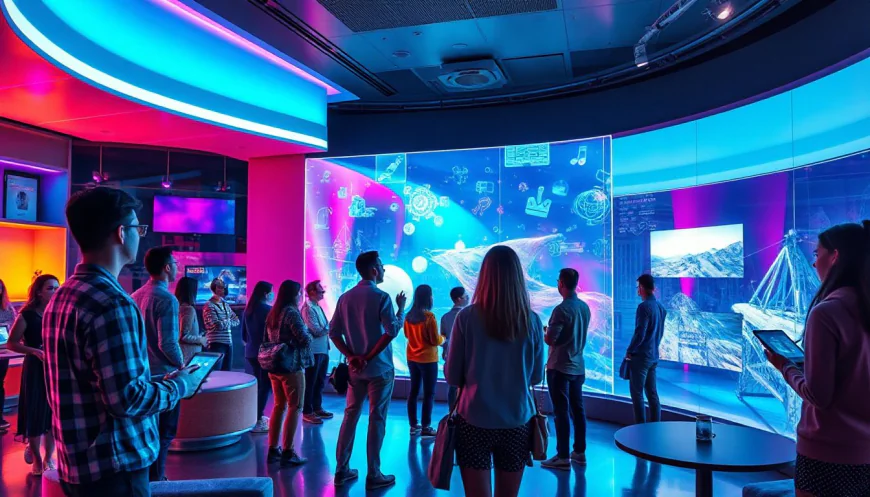Tech-Enhanced Storytelling: Interactive Narratives and Immersive Media
Technology is reshaping how stories are told. From simple books to complex digital experiences, each new tool adds layers of engagement. Today, interactive stories and immersive media are changing the game entirely. They give audiences real choices and feelings of being part of the story. For content creators, marketers, and educators, this shift means new ways to connect and inspire. Staying ahead requires understanding these technologies and how to use them effectively.

The Evolution of Storytelling with Technology
The Shift from Traditional to Digital Narratives
Stories started on cave walls, then moved to books, radio, and TV. Now, we tell stories through screens, apps, and virtual worlds. This change brought more ways to entertain, teach, and share. But it also brought limits. Traditional storytelling is often passive, where audiences watch or listen without influence. Digital tools break that barrier. They invite viewers to participate and shape the experience.
Key Technologies Driving Innovation
New tech has pushed storytelling forward. Virtual Reality (VR) creates face-to-face, 3D environments. Augmented Reality (AR) adds digital images to the real world through smartphones or glasses. Mixed Reality (MR) combines both, blending real and virtual seamlessly. We've also seen 360-degree videos that let viewers look around as if they are inside the story. AI powers many interactive narratives, making stories smarter and more responsive. These advances have led to milestones like immersive documentaries, interactive games, and virtual museums.
Interactive Narratives: Engaging Audiences Through Choice and Agency
Defining Interactive Stories
What makes an interactive story stand out? Unlike a movie or book where the outcome stays the same, these stories give readers or viewers control. They can make choices that affect how the story plays out. Think of web comics with clickable paths or video games that change based on your decisions. The charm lies in feeling like you're part of the story, not just watching it unfold.
Benefits of Interactivity in Storytelling
Adding choices boosts engagement. People spend more time exploring stories when they influence outcomes. It builds an emotional bond—characters can react to decisions, making the experience personal. A good example is Netflix’s "Bandersnatch." Viewers pick what the main character does, leading to a different ending each time. That’s why interactivity keeps people hooked and eager to try different paths.
Tips for Creating Effective Interactive Content
- Make choices meaningful, not just for show. Each option should impact the story.
- Use data to see what your audience prefers. This helps craft better stories over time.
- Keep the interface simple. A confusing design ruins the experience.
- Test your story on real users, then tweak it for flow and clarity.
- Remember, engaging stories balance interactivity with a clear narrative thread.
Immersive Media: Creating Deeply Engaging Digital Environments
The Power of Virtual and Augmented Reality
VR and AR don’t just entertain—they make users feel part of something big. Step inside a virtual world or see digital objects in your space. It feels real, like you’re actually there. Businesses use VR for training, museums for storytelling, and advertisers for immersive ads. These tools turn passive viewers into active explorers.
Building Immersive Narratives
Designing these environments takes some skill. Focus on creating believable worlds that invite exploration. Use spatial sounds, so audio feels like it comes from specific directions. Haptic devices give physical feedback—like feeling an object in your hand inside VR. Use vivid graphics and realistic models to boost immersion. A good example is VR museum exhibits, where visitors walk through ancient temples or art galleries virtually.
Future Trends in Immersive Media
Headset tech keeps improving and costs are dropping, making VR and AR more accessible. AI will make environments respond dynamically to user actions, keeping each experience unique. Industry leaders predict more blur between games, education, and social media as these tools grow smarter and more versatile.
Challenges and Opportunities in Tech-Enhanced Storytelling
Technical and Creative Challenges
Developing these stories isn’t cheap or easy. Hardware can be costly, and building complex environments takes time. Creators must also find a way to let users explore freely without losing track of the story. Balancing user agency with a coherent narrative is a tricky task.
Ethical and Privacy Considerations
Collecting data from users makes immersive stories more personalized. But it also raises privacy concerns. Protecting user info must come first. Plus, creating accessible stories for everyone—regardless of physical ability or background—is essential. Inclusive design isn’t optional anymore; it’s a must.
Opportunities for Innovation
The future is full of potential. AI can tailor experiences to each person, making stories feel even more personal. Cross-platform experiences allow users to switch devices without losing their place. Immersive storytelling can shape education, social movements, and beyond, making learning more engaging and memorable.
Conclusion
Tech-enhanced storytelling is changing how we experience stories altogether. Interactive narratives invite us to make choices, while immersive media pulls us into new worlds. These tools offer endless ways to connect, learn, and entertain. For creators, embracing these technologies means standing out and making a real impact. To succeed, focus on clear storytelling, genuine user engagement, and smart tech use. The future belongs to storytellers who can combine imagination with innovation.
Start experimenting today—your audience is waiting to be part of your next story.



 VARSHITHA
VARSHITHA